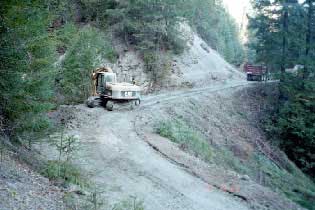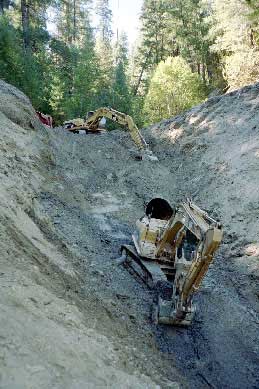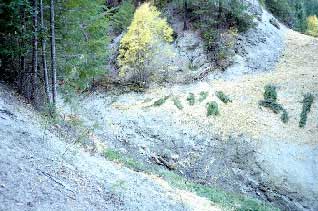RCD Completes Seventh Year of Restoration in South
Fork Trinity River
 |
BEFORE
Imagine a football field covered from end-zone to end-zone with 13 feet
of dirt. That's about 23,000 cubic yards of soil and how much the RCD
removed from stream crossings along 2.8 miles of old Forest Service roads
in the Upper South Fork and Happy Camp watersheds last year. This soil,
if not removed, poses a severe threat of being washed into the South Fork
Trinity River, which already has a problem with the amount of sediment
that gets into the river each winter damaging critical habitat for salmon
(See Fall 2003 Conservation Almanac "RCD
Completes South Fork Trinity River Monitoring Project").
Cynthia Tarwater, Project Coordinator, led the District team that oversaw
local contractors, who implemented last summer's work, which included
hydroclosing 2.1 miles and decommissioning 0.7 miles of roads. Hydroclosing
consists of removing all of the drainage structures from the roadway.
Hydroclosed roads are "put to bed" indefinitely to reduce the
impacts to fisheries habitat, but can be reopened for future timber management,
fire control or forest stewardship projects.
Decommissioning a road includes removing all culverts and hardware permanently;
ripping the road bed and reshaping it to match the original contours of
the land, as shown in the accompanying photos. Roads that are targeted
for decommissioning pose a higher threat to fisheries and are no longer
needed for forest management. Therefore, they are completely removed and
are not intended to be reopened.
The California Department of Fish and Game's California Coastal
Salmon Recovery Program and the Trinity County Resource
Advisory Committee funded the work described in this article.
 |
DURING
The RCD has been implementing road-related, sediment
reduction projects in the South Fork Trinity River Watershed since 1997,
including a third category of project--upgrading roads. Upgrading roads
reduces the potential for soil to reach the streams and keeps the roads
drivable by redesigning the drainage of the road, especially through the
installation of larger culverts that can withstand 100-year storms. To
date, nearly 163 miles of roads have been treated with 67 stream crossings
upgraded, 92 stream crossings excavated and over 70,000 cubic yards of
soil excavated from the stream courses. The Bureau of Reclamation's
Trinity River Restoration Program, the USFS
and California Department of Fish and Game have funded
this work in the past.
The District will be back in the South Fork Trinity River Watershed in
2004 with funding from the State Water Resources Control Board's
319(h) Program, the USFS and Trinity County RAC.
For more information on the important resource conservation program visit
the District's website to view back issues of the Conservation Almanac.
 |
AFTER
|


